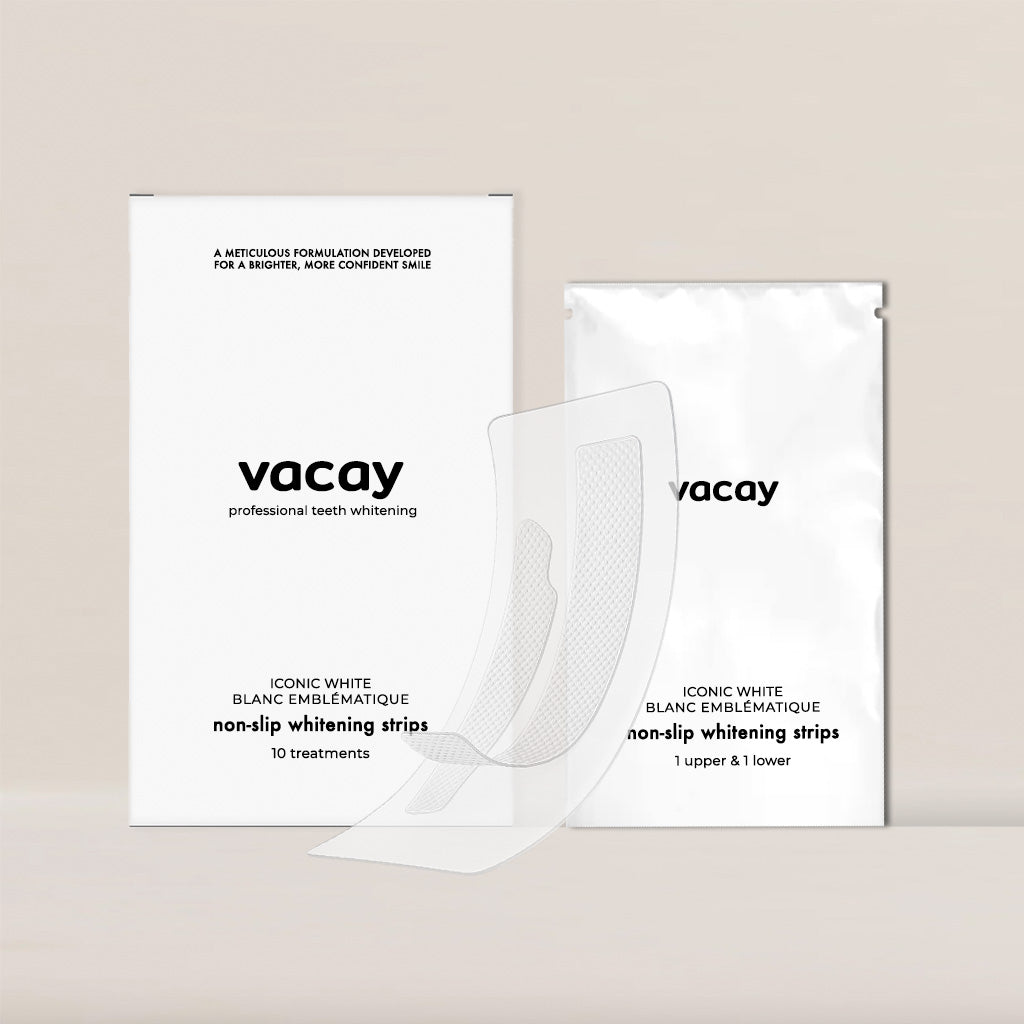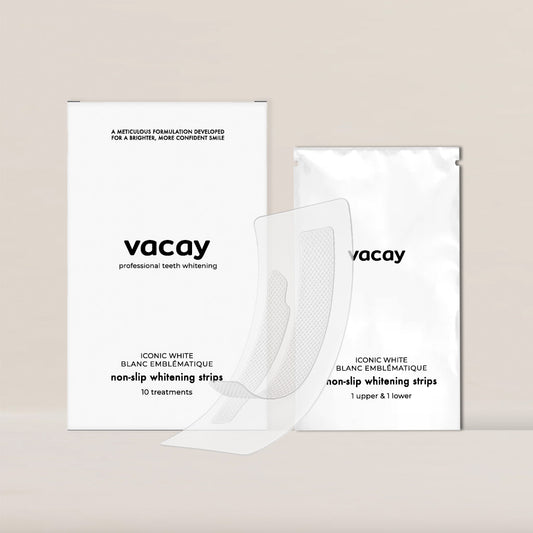
What Dentists Really Think About Whitening Strips
Whiter teeth without the sensitivity? Yes, please.Teeth whitening strips have become a go-to in the world of whitening products, but what do dental professionals really think about them? Are teeth whitening strips effective, or are they just another beauty aisle promise?
Here’s the expert-backed truth about how whitening strips work, how to use them safely (especially for sensitive teeth), and what kind of whitening results you can actually expect. Teeth whitening strips work by using active ingredients, such as hydrogen peroxide or carbamide peroxide, which penetrate the enamel to oxidize and break down stain molecules from coffee, smoking, and other sources. These active ingredients are key to the formulation and effectiveness of the strips, targeting stains to improve teeth appearance. As a result, users can achieve a noticeably brighter, more attractive smile, often referred to as a bright smile, after consistent use.
The Truth About Teeth Whitening: What You Need to Know First
If you’re dreaming of a brighter, whiter smile, teeth whitening strips might seem like the perfect solution. But before you start your first treatment, it’s important to know how these strips actually work and what you can expect. Teeth whitening strips use a whitening agent—usually hydrogen peroxide or carbamide peroxide—that penetrates your enamel to break down surface stains and discoloration. When used as directed, these strips can deliver noticeable results, making them a true game changer for anyone looking to enhance their smile at home.
However, not all teeth are the same. If you have sensitive teeth, you might experience some tooth sensitivity during or after whitening. This is a common side effect, but it’s usually temporary. To get the best results and avoid unnecessary sensitivity, always follow the instructions on your strips and don’t overdo it. With the right approach, you’ll be on your way to a whiter, brighter smile—without the guesswork.
Why Dentists Still Recommend Whitening Strips
Teeth whitening strips aren’t just a trend—they’re a legit way to whiten natural teeth at home when used correctly. Many contain hydrogen peroxide or carbamide peroxide, proven whitening agents that remove stains from enamel and brighten your smile over time. Some whitening strips also include features for enhancing the fit and grip, which can lead to better results and greater user comfort.
Dentists typically like them because:
- They’re enamel-safe when used as directed
- They help reduce surface stains from coffee, red wine, and staining foods
- They’re a low-commitment way to try teeth whitening before moving to professional treatments
Choosing a reputable brand is important for ensuring the safety and effectiveness of whitening strips.
“Strips can be a great option for patients who want visible results without the cost of in-office whitening,” says one dentist on Reddit.
What’s Inside: The Ingredients That Make Whitening Strips Work
The secret behind the effectiveness of teeth whitening strips lies in their ingredients. Most strips rely on hydrogen peroxide as the primary whitening agent, which is proven to safely and effectively break down stubborn stains on your teeth. Some formulas use carbamide peroxide, which works in a similar way to deliver a noticeable whitening effect. To help minimize tooth sensitivity, many strips now include soothing ingredients like coconut oil or hydroxypropyl cellulose, which can help protect sensitive teeth and enhance your overall whitening experience.
You might also find ingredients like PVP in some strips, which help the whitening gel stick to your teeth for better coverage. When shopping for a whitening strip, look for products that are enamel safe and specifically designed for sensitive teeth. The right combination of ingredients can make all the difference in achieving a whiter smile without unwanted sensitivity.
The Downsides: Tooth Sensitivity + Uneven Whitening
Not all strips are created equal—and not all gums love them. Here’s what to watch for:
- Tooth sensitivity is the most common issue. Some users may experience sensitivity while using whitening strips, especially those with high concentrations of hydrogen peroxide or carbamide peroxide, which can irritate soft tissue or make sensitive teeth more reactive.
- Uneven whitening happens when strips don’t fully cover the bottom teeth or hug the gumline tightly. Strips with a thin design can offer more comfort, a better fit, and improved coverage, while a non slip design (like Vacay’s) and dry teeth before application make a huge difference.
- Restorations like crowns or veneers won’t whiten. Strips only brighten natural teeth, so any dental work may stay the same color—something to keep in mind if you’re aiming for a uniform smile.
Whitening Strips vs. Professional Whitening: What's the Difference?
|
Feature |
Whitening Strips |
Professional Whitening |
|---|---|---|
|
Whitening Agent |
Hydrogen peroxide or carbamide peroxide |
Higher concentration, dentist-applied |
|
Whitening Effect |
1–2 shades lighter in 7–10 days |
Up to 8 shades whiter in one session |
|
Cost |
Affordable, at-home option |
$$$ but fast and dramatic |
|
Enamel Safety |
Generally safe with clean ingredients |
Safe under dental supervision |
|
Custom Fit |
One-size-fits-most; may miss spots |
Custom trays = even coverage |
Professional whitening treatments often deliver faster results than over-the-counter options like strips, making them ideal for those seeking noticeable changes quickly.
Whitening trays are custom-fitted dental devices filled with professional-grade bleaching gel, offering more even and significant whitening compared to strips. Both strips and trays are worn over the teeth for a set period during treatment to achieve the desired whitening effect.
The Non-Slip Revolution: Why It Matters for Your Smile
If you’ve ever struggled with whitening strips that slide around or don’t stay put, you’ll appreciate the non-slip revolution in teeth whitening. Non-slip teeth whitening strips are designed to hug your teeth securely, ensuring the whitening gel stays in direct contact with your enamel for the full treatment time. This not only boosts the whitening effect but also makes the process more comfortable—especially for those with sensitive teeth.
A non slip design means you can talk, move, and go about your routine without worrying about the strip shifting or causing irritation. For anyone seeking a whiter smile with less hassle, non-slip strips are a simple upgrade that delivers a more even, effective, and enjoyable whitening experience.
Dentist-Backed Tips for Best Whitening Results
If you’re trying teeth whitening strips at home, here’s what the pros recommend:
- Brush before and after using whitening strips, dry teeth completely, and then apply strips. Brushing helps remove plaque and ensures the whitening ingredients like hydrogen peroxide and ingredients PVP work effectively.
- Rinse your mouth after removing the strips to clear away any residue and freshen your mouth before further brushing or eating.
- Use a whitening toothpaste in the morning to maintain your whitening effect and fight new stains.
- Be mindful of lifestyle habits such as drinking coffee or smoking, as these can contribute to staining and reduce the longevity of your whitening results.
- Avoid staining foods and drinks like red wine and coffee right after you peel off your strips.
- Don’t overuse them—give your enamel a break between treatments.
- Choose clean formulas with coconut oil or soothing ingredients to support sensitive gums.
Meet Your New Favorite Whitening Strips
Vacay Teeth Whitening Strips are formulated for real-life smiles. That means:
- A VitalNourish™ Blend of minerals, coconut oil, and sage oil to protect enamel
- A non slip design that hugs teeth—no sliding, slipping, or weird aftertaste
- Hydrogen peroxide for true whitening, minus the harsh burn
- No SLS, no artificial dyes, and nothing you wouldn’t want near your smile
Some kits also include bonus treatments that can be used separately to enhance or prolong your whitening results over time.
They’re easy to work into your morning routine, safe for home teeth use, and designed to deliver noticeable results—without making your sensitive teeth flinch. Whitening gels are also available as an alternative or complement to strips, offering a mess-free, gentle option that effectively removes stains and works well for sensitive teeth.
The Whitening Strip Aisle: Brands Dentists Trust (and Those They Don’t)
With so many teeth whitening strips on the market, it can be tough to know which brands actually deliver on their promises. Dental professionals often recommend trusted names like Crest and Colgate, which have a long history of safe, effective whitening. Newer brands like Vacay are also gaining attention for their innovative features, such as non-slip designs and natural ingredients that help reduce tooth sensitivity.
However, not all whitening strips are created equal. Some other brands may not provide the same level of whitening or could even increase sensitivity if the formula isn’t enamel safe. That’s why it’s important to do your homework: read reviews, check for dentist recommendations, and look for products that consistently deliver noticeable results without causing discomfort. Choosing the right whitening strip can make all the difference in your journey to a brighter smile.
Whitening Strips Do Work—When You Use the Right Ones
Teeth whitening strips can absolutely help you get a brighter, whiter smile—especially if you follow expert advice and choose clean, enamel-safe formulas. Wearing whitening strips is comfortable and convenient, allowing you to go about your daily routine while they work.
For a confidence boost that fits into your lifestyle (and actually respects your enamel), Vacay teeth whitening strips are the kind of game changer your smile deserves.
✨ Try them for 10 days and see the difference.
Are Whitening Strips the Game Changer in Oral Care?
Teeth whitening strips have truly changed the game for anyone looking to enhance their natural teeth and achieve a whiter smile at home. When used properly, these strips can effectively remove surface stains from coffee, red wine, and other daily culprits, giving you a more radiant and confident smile. While tooth sensitivity and uneven whitening are possible, choosing a high-quality, enamel-safe product and following the instructions can help you avoid most issues.
Whether you want to remove stains or simply brighten your smile, teeth whitening strips offer a convenient, affordable, and effective solution. With a little patience and the right product, you’ll see noticeable results and enjoy the benefits of a brighter, healthier smile—no dentist appointment required. For many, that’s a true game changer in oral care.




